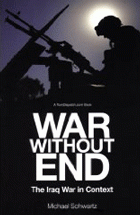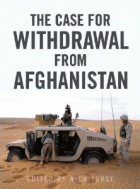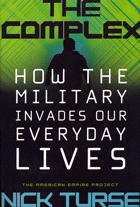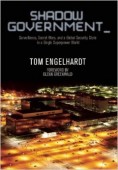[Note for TomDispatch Readers: A small reminder that our special offer for John Dower's new Dispatch Book, The Violent American Century: War and Terror Since World War Two, at an exclusive TD discount of 50% off, is still available at Haymarket Books and can be accessed by clicking on this link and following the checkout instructions you’ll see there. It's a great deal for a new work that couldn't be more disturbingly relevant. (To get a taste of it, check out the recent excerpt posted at TomDispatch.) It's also the capstone work in the career of a remarkable historian whose past books have swept prizes ranging from the National Book Award to a Pulitzer. Juan Cole writes that Dower is "our most judicious guide to the dark underbelly of postwar American power in the world." Adam Hochschild calls the book "mandatory reading." Seymour Hersh adds, "No historian understands the human cost of war, with its paranoia, madness, and violence, as does John Dower." What more can I say, except pick up a copy and in the process support this website? Tom]
Demobilizing America
A Nation Made by War and a Citizenry Unmade By It
By Tom Engelhardt
On successive days recently, I saw two museum shows that caught something of a lost American world and seemed eerily relevant in the Age of Trump. The first, “Hippie Modernism,” an exploration of the counterculture of the 1960s and 1970s (heavy on psychedelic posters), was appropriately enough at the Berkeley Art Museum. To my surprise, it also included a few artifacts from a movement crucial to my own not-especially-countercultural version of those years: the vast antiwar protests that took to the streets in the mid-1960s, shook the country, and never really went away until the last American combat troops were finally withdrawn from Vietnam in 1973. Included was a poster of the American flag, upside down, its stripes redrawn as red rifles, its stars as blue fighter planes, and another showing an American soldier, a rifle casually slung over his shoulder. Its caption still seems relevant as our never-ending wars continue to head for “the homeland.”
“Violence abroad,” it said, “breeds violence at home.” Amen, brother.
[Note for TomDispatch Readers: With today’s post and the first announcement of Alfred McCoy’s new Dispatch Book (coming this fall), you can finally see the full range of the TD book publishing program for 2017: John Feffer’s unsettling dystopian novel Splinterlands, John Dower’s powerful look at The Violent American Century, and McCoy’s upcoming In the Shadows of the American Century: The Rise and Decline of U.S. Global Power (which can be pre-ordered). My hope is that TomDispatch readers will set aside a little bookshelf space for our growing publishing program and make sure to pick up copies of our books. That will help keep us going, while these volumes, like the posts at this site, are guaranteed to offer you frameworks for reconsidering our American world in ways you will seldom find elsewhere, certainly not in the mainstream of this culture.
Note as well that, for a contribution of $100 ($125 if you live outside the U.S.), signed, personalized copies of Splinterlands and also of Jon Else’s powerful new book on the civil rights movement, True South, are still available at our donation page. Check it out! Tom]
Whatever the relations may or may not have been between Donald Trump and his crew and Vladimir Putin and his crew, here’s one thing that the two presidents do not have in common: popularity. According to polls, Putin’s approval rating was at 82% late last year. In his 17-year reign, he’s never fallen below the 60% mark, and when his figures did drop modestly, his military-first projection of Russian power in the Crimea and then Syria turned things around. Trump, on the other hand, barely squeaked to victory last November without even winning the popular vote -- you remember all those undocumented aliens, millions of them, who snuck into the polling booths! -- and his approval rating recently hit a distinctly non-Putinesque 36% in a Gallup poll, a figure unique for American presidents in their “honeymoon” periods and below all-time lows for, among others, Barack Obama, Bill Clinton, Dwight Eisenhower, and even Gerald Ford.
And if we’re talking about the rest of the global roster of right-wing populists TomDispatch regular Alfred McCoy focuses on today, things don’t look much better for The Donald. Philippine President Rodrigo Duterte, for instance, who has loosed his country’s police in a brutal killing campaign that’s littered Filipino urban landscapes with the bodies of thousands of drug pushers and users, stood at an 83% approval rating in January, down from his September 2016 high of 86%. Unfortunately for Trump, in the wake of the recent Obamacare fiasco, there’s no obvious way to recover domestically, no less soar to the heights presently reached by the Russian and Philippine strongmen. He does, however, have at his command something that neither Putin, Duterte, or any other populist figure can call upon: a military unparalleled on the planet --- and don’t for a second think that, if things continue going this badly, it won’t cross his mind that creating his own “Crimea” might have certain plusses, that “bombing the shit” out of distant enemies (rather than murdering pushers at home) might perk up those polling figures a bit. Taking out enemies, as McCoy makes clear, is an eternally popular way for such politicians to make their mark. The only problem: if the U.S. military is unparalleled in its destructive power in these years, it’s also had an unparalleled inability to bring any conflict it enters to a positive conclusion or, as Trump puts it, to start “winning wars again.”
It’s a record that would worry any populist looking for advantage and it’s part of a larger historical record, now including the election of Donald J. Trump, which should bring the word “decline” (as in the decline and fall of...) to all our lips. Alfred McCoy has had that very word on his mind for a while. His timely new Dispatch Book, In the Shadows of the American Century: The Rise and Decline of U.S. Global Power, will be published this fall at a moment when all of this may seem far more obvious. In the meantime, on our increasingly fragmented, seemingly degrading planet, he does something you don’t often see and groups the whole crew of global populists of our moment in one place to consider just what we should make of their rise -- and our potential fall. Tom
The Bloodstained Rise of Global Populism
A Political Movement’s Violent Pursuit of “Enemies”
By Alfred W. McCoyIn 2016, something extraordinary happened in the politics of diverse countries around the world. With surprising speed and simultaneity, a new generation of populist leaders emerged from the margins of nominally democratic nations to win power. In doing so, they gave voice, often in virulent fashion, to public concerns about the social costs of globalization.
Even in societies as disparate as the affluent United States and the impoverished Philippines, similarly violent strains of populist rhetoric carried two unlikely candidates from the political margins to the presidency. On opposite sides of the Pacific, these outsider campaigns were framed by lurid calls for violence and even murder.
As his insurgent crusade gained momentum, billionaire Donald Trump moved beyond his repeated promises to fight Islamic terror with torture and brutal bombing by also advocating the murder of women and children. “The other thing with the terrorists is you have to take out their families, when you get these terrorists, you have to take out their families,” he told Fox News. “They care about their lives, don’t kid yourself. When they say they don’t care about their lives, you have to take out their families.”
Terror attacks like the recent one in London send a shudder through Americans. Since 9/11, they have been the definition of what TomDispatch regular Rajan Menon calls “national (in)security.” They've also been the lifeblood of a media machine that loves to focus 24/7 on immediate and obvious horrors (especially against folks like “us”). In the age of Donald Trump, preventing such attacks has, if anything, become even more the essence of what American security is all about.
And yet, in the context of the insecurity to come in this world, they are essentially nothing. It is, of course, a terrible thing when some disturbed fanatic or set of fanatics gun down or run down innocent civilians in London, Berlin, Paris, or San Bernardino (as it should be, but in our American world isn’t, when a U.S. plane or drone kills innocent civilians in distant lands). But if, for a moment, you stop to think in either nuclear terms (as in the pairing of North Korea’s unnerving leader Kim Jong-un and Donald Trump) or in climate change terms, then those attacks are the smallest of potatoes when it comes to national insecurity. If you really want to think about acts of “terror,” consider what Donald Trump and his climate-denying crew at the Environmental Protection Agency and elsewhere in his administration would like to do to the environmental policies of the world’s second-largest emitter of greenhouse gases.
Trump's urge is clearly to negate every positive act of the Obama administration when it comes to reining in the use of fossil fuels -- from the Paris climate agreement to the Clean Power Plan aimed at shutting down coal-fired power plants. In the end, if a Trump presidency takes this country out of the climate change sweepstakes entirely, if it opens the flood (and fracking) gates yet wider on the development of fossil fuels of every sort while tamping down the development of alternative energy sources, you’re talking about an act of terror on a scale that would once have been inconceivable. What the Trump administration is already trying to do should lead to constant headlines of a sort that would put the recent London ones to shame. However, because the full impact of Trump’s climate terror won’t strike home until the era of our grandchildren or even great-grandchildren, because his version of terror will be enacted on a time scale that plays havoc with our usual sense of history and of our own lives, he’ll undoubtedly get only the most modest of attention for it -- while Khalid Masood, the London killer, and his successors will remain the eternal headliners du jour.
Still, make no mistake about it, in his rented vehicle of choice President Trump will run over future generations. Even on a less drastic time scale, as Rajan Menon makes vividly clear today, he will certainly prove to be a heavyweight in the national (in)security business. Tom
National (In)security
What a Trump Presidency Really Means for Americans at the Edge
By Rajan MenonDonald Trump’s supporters believe that his election will end business as usual in Washington. The self-glorifying Trump agrees and indeed his has, so far, been the most unorthodox presidency of our era, if not any era. It’s a chaotic and tweet-driven administration that makes headlines daily thanks to scandals, acts of stunning incompetence, rants, accusations, wild claims, and conspiracy theories. On one crucial issue, however, Trump has been a complete conformist. Despite the headline-grabbing uproar over Muslim bans and the like, his stance on national security couldn’t be more recognizable. His list of major threats -- terrorism, Iran, North Korea, and China -- features the usual suspects that Republicans, Democrats, and the foreign policy establishment have long deemed dangerous.
[Note for TomDispatch Readers: With some pride, I’m announcing today the newest Dispatch Book. It’s also the capstone on eminent historian John Dower’s work on America’s wars, including his National Book Critics Circle Award-winning War Without Mercy and his Pulitzer Prize-winning Embracing Defeat. His new book, The Violent American Century: War and Terror Since World War Two, is about to be published. Given the deluge of “news” that is the Trump era and everyone’s sudden lack of reading time, it’s a mercifully short, sharp, timely, and definitive look at what “the American Century” has really meant in terms of violence. I consider it a true must-read for our moment. And I’m not alone.
Among a crowd of people who have praised the book, Noam Chomsky says: “John Dower ends this grim recounting of 75 years of constant war, intervention, assassination, and other crimes by calling for ‘serious consideration’ of why the most powerful nation in world history is so dedicated to these practices while ignoring the nature of its actions and their consequences -- an injunction that could hardly be more timely or necessary as the Pentagon’s ‘arc of instability’ expands to an ‘ocean of instability’ and even an 'atomic arc of instability' in Dower’s perceptive reflections on today’s frightening world." Andrew Bacevich adds: “A timely, compact, and utterly compelling exposé of the myriad contradictions besetting U.S. national security policy... a powerful book.” And Seymour Hersh writes: “No historian understands the human cost of war, with its paranoia, madness, and violence, as does John Dower, and in this deeply researched volume he tells how America, since the end of World War II, has turned away from its ideals and goodness to become a match setting the world on fire.”
I hope all TomDispatch readers will pick-up a copy. You can go to Amazon.com and pre-order one now (and make TD a few cents at no cost to you) by clicking on this link or you can order a copy directly from Haymarket Books at an exclusive discount for TD readers of 50%, simply by clicking on this link and following the checkout instructions you’ll see there. However you do it, buy The Violent American Century and support our new book publishing program! Tom]
Recently, the historian Marilyn Young, an old friend, died. She spent her life writing about America’s wars and a country at war. Her New York Times obituary quoted this telling passage from a speech she gave to the Society for Historians of American Foreign Relations:
“I find that I have spent most of my life as a teacher and scholar thinking and writing about war. I moved from war to war, from the War of 1898 and U.S. participation in the Boxer Expedition and the Chinese civil war, to the Vietnam War, back to the Korean War, then further back to World War II and forward to the wars of the twentieth and early twenty-first centuries. Initially, I wrote about all these as if war and peace were discrete: prewar, war, peace, or postwar. Over time, this progression of wars has looked to me less like a progression than a continuation: as if between one war and the next, the country was on hold.”
Curiously enough, with the exception of World War II and Vietnam (for quite different reasons), Americans have lived through our many wars of the last century, years drenched in blood and suffering when this country became the most dominant power on the planet, in a state of relative obliviousness. Nonetheless, peaceable as the United States seemed in those decades domestically, its wars did come home in all sorts of ways or you would have a hard time explaining the militarization of this country, the growth of the Pentagon budget to staggering proportions, and the rise of the national security state (and its surveillance systems).
That’s why John Dower’s new book, The Violent American Century: War and Terror Since World War Two, arrives at such an opportune moment, just as the era of Donald Trump begins with a visible ramping up (yet again) of America’s wars across the Greater Middle East. It offers a rare assessment of what that century’s human toll actually looks like and of our country’s involvement in it. In his article today, adapted from that book’s first chapter, Dower offers some striking thoughts on how to begin to measure the toll of the last 75 years of global war and conflict. And I must admit that, under the circumstances, it seems particularly fitting to me that Marilyn Young gave what must have been the last blurb of her life to his book, writing, “In The Violent American Century, John Dower has produced a sharply eloquent account of the use of U.S. military power since World War II. From ‘hot’ Cold War conflicts to drone strikes, Dower examines the machinery of American violence and its staggering toll. This is an indispensable book.” Tom
An American Century of Carnage
Measuring Violence in a Single Superpower World
By John W. Dower[This essay is adapted from “Measuring Violence,” the first chapter of John Dower’s new book, The Violent American Century: War and Terror Since World War Two.]
On February 17, 1941, almost 10 months before Japan’s attack on Pearl Harbor, Life magazine carried a lengthy essay by its publisher, Henry Luce, entitled “The American Century.” The son of Presbyterian missionaries, born in China in 1898 and raised there until the age of 15, Luce essentially transposed the certainty of religious dogma into the certainty of a nationalistic mission couched in the name of internationalism.
Luce acknowledged that the United States could not police the whole world or attempt to impose democratic institutions on all of mankind. Nonetheless, “the world of the 20th Century,” he wrote, “if it is to come to life in any nobility of health and vigor, must be to a significant degree an American Century.” The essay called on all Americans “to accept wholeheartedly our duty and our opportunity as the most powerful and vital nation in the world and in consequence to exert upon the world the full impact of our influence, for such purposes as we see fit and by such measures as we see fit.”
[Note for TomDispatch Readers: Here’s a special offer for you. Today’s author Jon Else was the series producer and cinematographer for the classic TV documentary on the civil rights movement, Eyes on the Prize. His book, True South has just been published. The New York Times calls it “warm and intelligent” and Adam Hochschild has hailed it as a “moving account of perhaps the greatest American documentary series ever made,” a story told “with the compassion and eloquence it deserves.” I’ve read it with fascination. As it happens, for a contribution to this website of $100 ($125 if you live outside the USA), you, too, can have it in your hands, signed and personalized by Else himself. Check out our donation page for the details. Tom]
It was one of the worst moments of the Vietnam War era in America. U.S. troops had just invaded Cambodia and the nation’s campuses erupted in a spasm of angry and frustrated protest. At Kent State University in Ohio, National Guardsmen had killed four students. In Washington that day in May 1970, the first of what would be vast crowds of protesters were beginning to gather in the pre-dawn hours when a restless President Richard Nixon with his valet Manolo Sanchez in tow had himself driven to the Lincoln Memorial. There, at 4:40 a.m., he met, shook some hands, and engaged in “a rambling dialogue” with some startled young demonstrators. (“I said, ‘I know you, probably most of you think I'm an SOB, but, ah, I want you to know that I understand just how you feel.’”)
The protesters were not exactly impressed. (“‘I hope it was because he was tired but most of what he was saying was absurd,’ one of the Syracuse students told the press afterward. ‘Here we had come from a university that's completely uptight, on strike, and when we told him where we were from, he talked about the football team.’”) But in that bizarre meeting in that embattled moment, you could still see the last dregs of a relationship between presidents of the United States and vast, mobilized movements, the first of which, as Jon Else explains today, was the civil rights movement. Nixon, who perfected “the southern strategy” of using implicit racial appeals to bring the previously Democratic white southern vote into the Republican fold, even alluded to that in his own odd fashion. (“I pointed out that I knew that on their campus, their campuses, a major subject of concern was the Negro problem. I said this was altogether as it should be, because the degradation of slavery had been imposed upon the Negroes, and it was, it would be impossible for us to do everything that we should do to right that wrong.”)
Almost half a century later, don’t expect President Trump to pay any pre-dawn visits to those arriving in Washington to protest his policies, no less consider their positions, or respond to them. As Else points out today, the ability of protesters to appeal successfully to Washington, vibrant in the civil rights era, dying in the Vietnam years, is now dead on arrival and protest, as it sweeps the country, will have to find other ways to make itself felt and effective. Else, whose new book, True South: Henry Hampton and "Eyes on the Prize," the Landmark Television Series That Reframed the Civil Rights Movement, is a moving look at the civil rights movement through one man’s life, frames our present grim moment in the context of that remarkable history. It’s a past worth remembering as the protest movement of the twenty-first century finds its way in a grim world. Tom
Not Your Grandma’s Civil Rights Strategy
Whose Streets? (Then and Now)
By Jon ElseOn a glorious afternoon in August 1963, after the massive March on Washington for Jobs and Freedom wrapped up on the national mall, President John F. Kennedy, prodded by Attorney General Robert Kennedy, welcomed John Lewis, Martin Luther King Jr., Bayard Rustin, and other march organizers to the White House for a discussion of proposed civil rights legislation. Fifty-four years later, on an afternoon in January 2017, when the even more massive Women’s March on Washington wrapped up, President Donald Trump responded with a sarcastic tweet. Just the day before, Trump’s team had removed the “civil rights” page from the issues section of the WhiteHouse.gov website and replaced it with a new entry entitled “Standing Up For Our Law Enforcement Community.” The page is still missing.
Today, with the three branches of government controlled by men intolerant of dissent and hounded by their own dark vision of pluralism, few human rights advocates of any stripe can reasonably expect a hearing in Washington. Our long-running, ongoing, unfinished American civil rights struggle that so often focused on pressing the federal government toward justice, is suddenly in uncharted territory. The legacy of Reverend Martin Luther King has slammed up against the legacy of Alabama Governor George Wallace, whose snarling campaign for president in 1968 has come home to roost in the presidency of Donald Trump. Where civil rights leaders, warriors, and foot soldiers found support in high places they will now find a void.



















